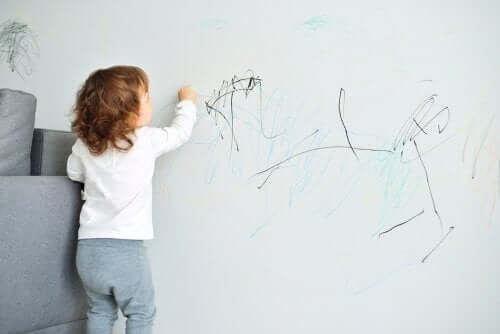Overcorrection as a Means of Behavior Modification

Raising and educating children is a complex job that requires great doses of patience. On occasion, it feels like we’ve tried everything to reduce our children’s inappropriate behaviors, to no avail. In this article, we’ll take a look at overcorrection, one of the most effective methods when it comes to behavior modification.
Your children play ball inside the house, fight with their sibling, write on the walls, and throw their toys. Despite the millions of times you’ve told them to stop, it always ends up happening again.
Without a doubt, your level of frustration has caused you to lose control and raise your voice. You can scold them, you can shout at them, and you can feel terrible for having done it, but… the same behaviors come back again and again.
So what can you do? Obviously we need to set limits, but constantly arguing and battling with our children is exhausting. Don’t give up. Overcorrection can be a great education tool if you find yourself in this situation. We’ll help you eliminate negative behaviors while at the same time training your child to behave appropriately.

Overcorrection: An operant technique that works
Behaviorism is a branch of psychology that studies behavior in relation to its consequences. According to behaviorism, the frequency with which a behavior appears will vary according to the consequences that follow that behavior.
If they are positive, the behavior will appear more frequently. Likewise, if the consequences are negative, the behavior will decrease.
There are two main ways to achieve this. If you want a certain behavior to become more frequent, then you will use positive reinforcement. However, if you want to reduce or eliminate the presence of some behavior, then you will use punishment.
Overcorrection, then, falls into the category of punishment techniques. This is because its objective is to reduce the frequency of undesired behavior. That being said, this technique has several advantages over other techniques in the same category:
- This technique is harmless when it comes to a child’s physical and psychological health and integrity. It causes no harm nor does it display any level of aggression (unlike physical punishment).
- The application of most punishment techniques may cause your child to develop resentment and other negative emotions towards whoever applies the punishment. However, when using overcorrection as a means of behavior modification, the chances of this happening are minimal.
- Overcorrection teaches children appropriate behaviors. Therefore, while we combat unpleasant behaviors, we also instill positive alternatives.
What is overcorrection?
We know that overcorrection is an operant technique that aims to eliminate negative behaviors. But, just how does it work. In this type of behavior modification, children perform an appropriate behavior that is directly related to whatever behavior it is that you want to eliminate.
This occurs in a repetitive or prolonged manner. What’s more, the performance of the appropriate behavior is contingent on the appearance of the inappropriate one.
In other words, for each inappropriate behavior, we must select another related behavior that is positive. Each time the inappropriate behavior occurs, the child must perform the desired behavior several times or for a prolonged period of time.
There are two ways to apply the overcorrection technique:

- Restitutive overcorrection: This method applies to those behaviors that have a disturbing or destructive effect on the environment. For example, if a child scribbles on the wall or on furniture. In this case, the idea is for children to fix the negative effects of their poor conduct… restoring the space or leaving it even better than it was originally. For example, asking your child to clean the table he or she scribbled on as well as the rest of the furniture in the room.
- Positive practice: In many cases, the behavior you want to eliminate doesn’t have any tangible negative effects on the environment. So then, you can use this second option. Positive practice consists of having children perform behaviors that are incompatible with those you want to eliminate, several times or as long as necessary. For example, you can tell your child to practice picking clothes up off the floor and place it in the laundry basket 10 times.
Logical consequences
As you can see, despite being a form of punishment, the punitive element isn’t arbitrary. Rather, it’s completely related to the problem behavior. This way, we teach our children through natural consequences and not through irrelevant punishments.
Restoring the environment or practicing an appropriate behavior has a much higher educational value than taking away a child’s TV time, for example.
Therefore, keep overcorrection in mind when there’s some conduct you want to change. We’re sure you’ll discover that it’s a highly effective behavior modification technique.
https://eresmama.com/sobrecorreccion-modificar-conductas-ninos/
Raising and educating children is a complex job that requires great doses of patience. On occasion, it feels like we’ve tried everything to reduce our children’s inappropriate behaviors, to no avail. In this article, we’ll take a look at overcorrection, one of the most effective methods when it comes to behavior modification.
Your children play ball inside the house, fight with their sibling, write on the walls, and throw their toys. Despite the millions of times you’ve told them to stop, it always ends up happening again.
Without a doubt, your level of frustration has caused you to lose control and raise your voice. You can scold them, you can shout at them, and you can feel terrible for having done it, but… the same behaviors come back again and again.
So what can you do? Obviously we need to set limits, but constantly arguing and battling with our children is exhausting. Don’t give up. Overcorrection can be a great education tool if you find yourself in this situation. We’ll help you eliminate negative behaviors while at the same time training your child to behave appropriately.

Overcorrection: An operant technique that works
Behaviorism is a branch of psychology that studies behavior in relation to its consequences. According to behaviorism, the frequency with which a behavior appears will vary according to the consequences that follow that behavior.
If they are positive, the behavior will appear more frequently. Likewise, if the consequences are negative, the behavior will decrease.
There are two main ways to achieve this. If you want a certain behavior to become more frequent, then you will use positive reinforcement. However, if you want to reduce or eliminate the presence of some behavior, then you will use punishment.
Overcorrection, then, falls into the category of punishment techniques. This is because its objective is to reduce the frequency of undesired behavior. That being said, this technique has several advantages over other techniques in the same category:
- This technique is harmless when it comes to a child’s physical and psychological health and integrity. It causes no harm nor does it display any level of aggression (unlike physical punishment).
- The application of most punishment techniques may cause your child to develop resentment and other negative emotions towards whoever applies the punishment. However, when using overcorrection as a means of behavior modification, the chances of this happening are minimal.
- Overcorrection teaches children appropriate behaviors. Therefore, while we combat unpleasant behaviors, we also instill positive alternatives.
What is overcorrection?
We know that overcorrection is an operant technique that aims to eliminate negative behaviors. But, just how does it work. In this type of behavior modification, children perform an appropriate behavior that is directly related to whatever behavior it is that you want to eliminate.
This occurs in a repetitive or prolonged manner. What’s more, the performance of the appropriate behavior is contingent on the appearance of the inappropriate one.
In other words, for each inappropriate behavior, we must select another related behavior that is positive. Each time the inappropriate behavior occurs, the child must perform the desired behavior several times or for a prolonged period of time.
There are two ways to apply the overcorrection technique:

- Restitutive overcorrection: This method applies to those behaviors that have a disturbing or destructive effect on the environment. For example, if a child scribbles on the wall or on furniture. In this case, the idea is for children to fix the negative effects of their poor conduct… restoring the space or leaving it even better than it was originally. For example, asking your child to clean the table he or she scribbled on as well as the rest of the furniture in the room.
- Positive practice: In many cases, the behavior you want to eliminate doesn’t have any tangible negative effects on the environment. So then, you can use this second option. Positive practice consists of having children perform behaviors that are incompatible with those you want to eliminate, several times or as long as necessary. For example, you can tell your child to practice picking clothes up off the floor and place it in the laundry basket 10 times.
Logical consequences
As you can see, despite being a form of punishment, the punitive element isn’t arbitrary. Rather, it’s completely related to the problem behavior. This way, we teach our children through natural consequences and not through irrelevant punishments.
Restoring the environment or practicing an appropriate behavior has a much higher educational value than taking away a child’s TV time, for example.
Therefore, keep overcorrection in mind when there’s some conduct you want to change. We’re sure you’ll discover that it’s a highly effective behavior modification technique.
https://eresmama.com/sobrecorreccion-modificar-conductas-ninos/
All cited sources were thoroughly reviewed by our team to ensure their quality, reliability, currency, and validity. The bibliography of this article was considered reliable and of academic or scientific accuracy.
- Bados, A., & García-Grau, E. (2011). Técnicas operantes. Departamento de personalidad, evaluación y tratamiento psicológicos: Universidad de Barcelona. Recuperado de http://diposit.ub.edu/dspace/bitstream/2445/18402/1/T% C3% A9cnicas% 20operantes, 20, 2011.
- Morant, M. E. L. (1995). Sobrecorrección: una revisión (Doctoral dissertation, Universitat de València).
This text is provided for informational purposes only and does not replace consultation with a professional. If in doubt, consult your specialist.








